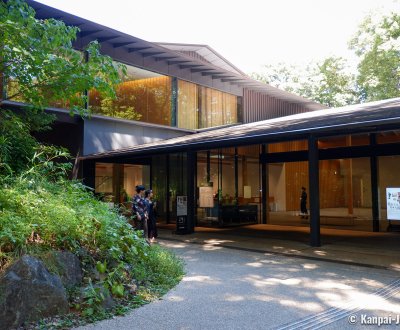Meiji Jingu Museum
Beautiful Architect Museum Dedicated To The Emperor
Meiji Jingu Museum is a museum located on the grounds of Meiji Jingu, a shrine nestled in the sacred forest of Tokyo’s Harajuku district. Dedicated to the Meiji Era (1868 – 1912) and to the founding of the large Shinto enclosure in the heart of the capital, the exhibition opened in 2019, sheltered in a contemporary architecture building designed by Kengo Kuma.
Inaugurated at the end of 2019, the new Meiji Jingu Museum celebrates the 100th anniversary of the sacred grounds enshrining the souls of Emperor Meiji (1852 – 1912) and his spouse Empress Shoken (1849 – 1914). The Meiji Era, defined by the opening to Western influences and its military feats, is an important landmark in the modern history of Japan, after the end of the Tokugawa shogunate and before the 2 World Wars of the first half of the 20th century. Founded in 1920, Meiji-jingu shrine is a posthumous tribute to the era, spreading on a large superficies in the heart of Tokyo.
Adjacent to Yoyogi Park, at the exit of Harajuku station, the Shinto enclosure is one of Tokyo’s most remarkable green lungs, with:
- A 70 hectares wood, where 100,000 trees from all over Japan have been growing since its creation;
- An inner Japanese garden designed by the emperor and called Meiji Jingu Gyoen; and,
- The detached complex of Meiji Jingu Gaien and its several sport facilities, including the new National Stadium.
Among the many pavilions to admire, Meiji Jingu Museum is the most recent, built on the side of the path leading to the sanctuary’s entrance. Its quietness makes it a perfect complement to the visit of the lively Meiji-jingu.

A design by Kengo Kuma immersed in the forest
Nestled in the heart of the large wooded park of Meiji-jingu, the new museum’s architecture was designed by Kengo Kuma. With an aerial, refined and low-key style, it harmoniously blends in the naturally lush landscape. Whether outside or inside the construction, one completely feels wrapped in the forest. The large bay windows at the ground floor offer a welcome contemplative break.
While it is modern, the building also displays characteristics of traditional Japanese architecture, especially the use of wood, sourced from the trees that were cut down on the museum's site. As a mean to limit its footprint on the century-old trees, the buildings is covered with several smaller roofs and is only 1-story high.

The first exhibition space unfolds the history of Meiji-jingu’s site and the Shinto rituals performed throughout the seasons. It is therefore a good introduction to the shrine before visiting it. At the 1rst floor, the second collection is a display of important cultural properties that belonged to Emperor Meiji and his wife. Portraits and various objects are displayed in a more subdued and intimate darkness. At the center of the room, the highlight is the imperial carriage the couple rode to parade on February 11, 1889 , the day of Japan’s first constitution promulgation. Note that taking pictures inside the exhibition room is forbidden. Documentary videos are played in a special room.
The admission fee is a bit expensive for a rather short visit time, but it will probably ensure a longer peace to this new sightseeing address.

